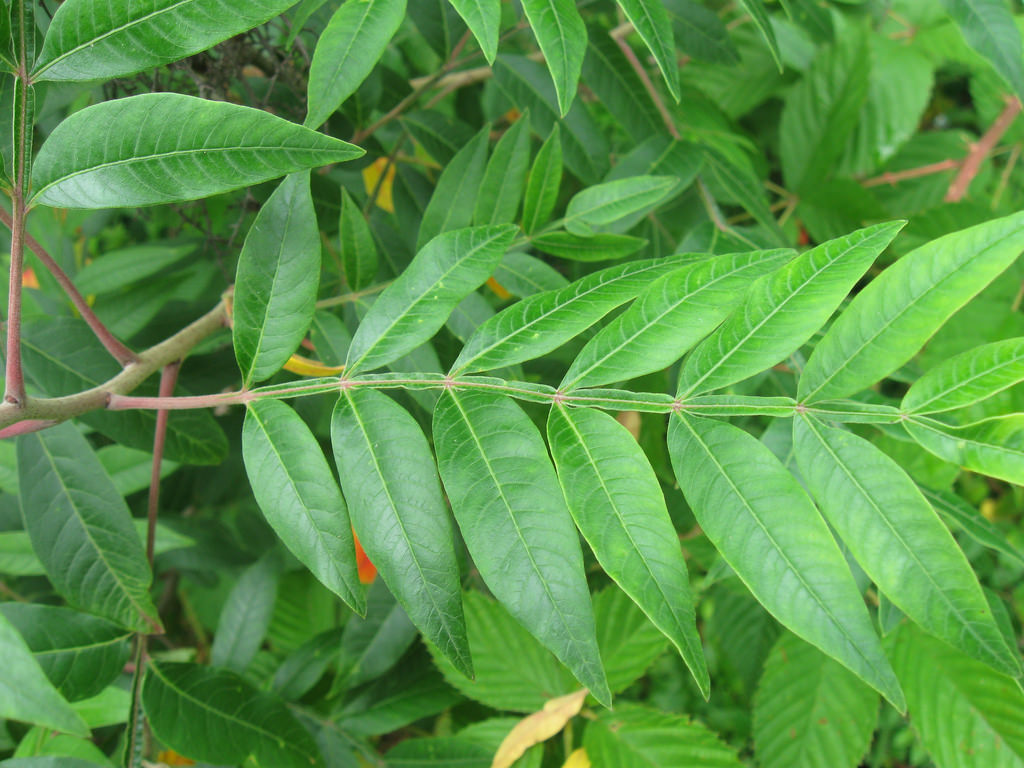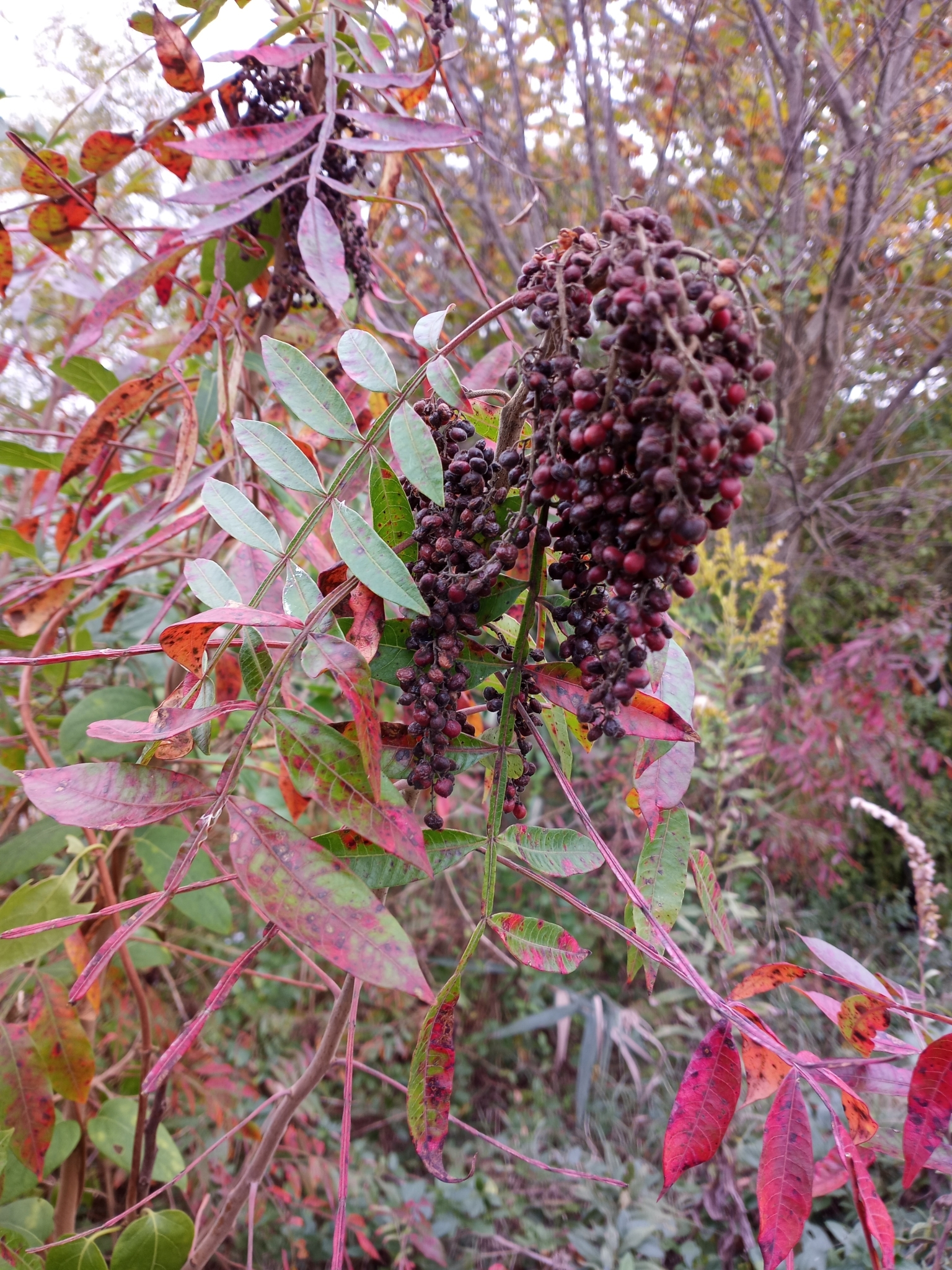Winged Sumac
Rhus copallinum L.
Description
Winged sumac is a member of the cashew family (Anacardaceae). Alternative common names include flame leaf sumac, dwarf sumac and shining sumac 5. This shrub or small tree that seldom reaches heights over can 10 feet ¹, but can reach 20 to 30 feet ³. The shoots spread vigorously by root sprouts, but end to lose vigor after 15 years ¹. The alternate leaves are 16 to 24 inches long, compound with 7 to 21 leaflets, and with “wings” that connect each leaf along the leafstalk ¹. Winged sumac is deciduous, and its leaves turn scarlet red in the fall ¹. Most populations of are dioecious with separate male and female plants ¹. During July and September, flowers will blossom and are a yellowish-green color ¹. The fruit is usually mature by the fall, and are red and hairy. Inside the fruit, each containing only one seed. Seed germination of the seed is usually enhanced by fires and by the digestion of mammals or birds ¹.

Leaf of winged sumac. @ W. Longbottom, 2016. Maryland Biodiversity Project ².

Fall leaf color and fruit of winged sumac. W. Longbottom, 2020. Maryland Biodiversity Project ².
Distribution
Winged sumac is distributed through the eastern United States all the way to the Midwest United States³. But also found in the northeastern part of Canada 4. With having such a vast area of native habitat, winged sumac is tolerant to drought and well adapted to fires³. The ideal conditions for this shrub are low bottomlands and well-drained soil³. In Maryland, winged sumac is found throughout the state but is most common on the coastal plain ².

Native distribution map of winged sumac. Wikimedia 4.
Wildlife Importance
The winged sumac serves as an emergency source of food for many species of birds ¹. When food is getting limited in the winter, white-tailed deer and rabbits will forage and eat the twigs³. Winged sumac produces berries and are desirable to songbirds, wild turkeys, and grouse³. When the berries are mature and ripe, they are a red color, and this tends to attract the animals ³. Winged sumac is host to numerous insects ². During the spring, when in flowers, this plant is important to pollinators such as butterflies and moths that collect the nectar 5. It is host to the Red-Banded Hairstreak and Luna moth 5. This helps with reproduction of the plant because the butterflies and moths pollinate to the female flowers 5.
Economic Importance
Winged sumac does not have a huge importance, but many people like to use this plant as an ornamental 6. Sometimes this is considered a pioneer species because they are easy to growand the bright red fall leaf color 1,7. Today winged sumac is usually consumed by people in a drink resembling lemonade from their berries 7. The berries are tart when the fruit is ripe 7. Just like grapes and apples, the berries of the winged sumac contain malic acid on the outside and people know its ripe when tasting the malic acid 7.
Threats
Winged sumac does not face many problems because it is quite “hardy” 8. It does face some host problems from insects like aphids and mites 8. This shrub might also face some leaf spots, sun damage, and some browning of the leaves 8.
Interesting Facts
- Rhus copallinum is resilient to fire. Fires actually stimulate the plants roots to sprout and helps with germination. Research has shown that after a fire burns, the plant has increased stem growth and total density ³.
- Rhus copallinum actually likes soil of conditions that are not nutrient rich. Prefers sandy or rocky soil, which it makes the plant superior to other species that inhibit the same space 9.
- The sap becomes black when exposed to the air and is gummy or resinous, which is the meaning of its species name 7.
References
- USDA-NRCS Plant Fact Sheet: Winged sumac
- Maryland Biodiversity Project: Rhus copallinum
- USDA-Forest Service Fire Effects Information System: Rhus copallinum
- Wikimedia Commons: Rhus copallinum
- North Carolina Extension: Rhus copallinum
- Lady Bird Johnson Wildflower Center: Rhus copallinum
- Eat the Weeds:–Sumac: more than just native lemonade
- Missouri Botanical Gardens: Rhus copallinum
- Illinois wildflowers: Winged sumac
